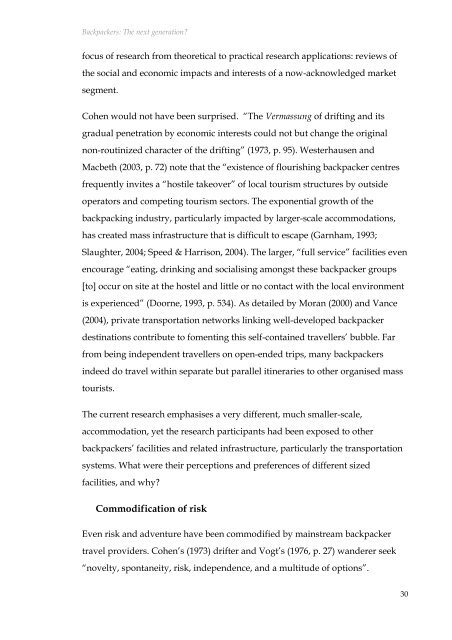Backpackers: The next generation? - Scholarly Commons Home
Backpackers: The next generation? - Scholarly Commons Home
Backpackers: The next generation? - Scholarly Commons Home
You also want an ePaper? Increase the reach of your titles
YUMPU automatically turns print PDFs into web optimized ePapers that Google loves.
<strong>Backpackers</strong>: <strong>The</strong> <strong>next</strong> <strong>generation</strong>?<br />
focus of research from theoretical to practical research applications: reviews of<br />
the social and economic impacts and interests of a now-acknowledged market<br />
segment.<br />
Cohen would not have been surprised. “<strong>The</strong> Vermassung of drifting and its<br />
gradual penetration by economic interests could not but change the original<br />
non-routinized character of the drifting” (1973, p. 95). Westerhausen and<br />
Macbeth (2003, p. 72) note that the “existence of flourishing backpacker centres<br />
frequently invites a “hostile takeover” of local tourism structures by outside<br />
operators and competing tourism sectors. <strong>The</strong> exponential growth of the<br />
backpacking industry, particularly impacted by larger-scale accommodations,<br />
has created mass infrastructure that is difficult to escape (Garnham, 1993;<br />
Slaughter, 2004; Speed & Harrison, 2004). <strong>The</strong> larger, “full service” facilities even<br />
encourage “eating, drinking and socialising amongst these backpacker groups<br />
[to] occur on site at the hostel and little or no contact with the local environment<br />
is experienced” (Doorne, 1993, p. 534). As detailed by Moran (2000) and Vance<br />
(2004), private transportation networks linking well-developed backpacker<br />
destinations contribute to fomenting this self-contained travellers’ bubble. Far<br />
from being independent travellers on open-ended trips, many backpackers<br />
indeed do travel within separate but parallel itineraries to other organised mass<br />
tourists.<br />
<strong>The</strong> current research emphasises a very different, much smaller-scale,<br />
accommodation, yet the research participants had been exposed to other<br />
backpackers’ facilities and related infrastructure, particularly the transportation<br />
systems. What were their perceptions and preferences of different sized<br />
facilities, and why?<br />
Commodification of risk<br />
Even risk and adventure have been commodified by mainstream backpacker<br />
travel providers. Cohen’s (1973) drifter and Vogt’s (1976, p. 27) wanderer seek<br />
“novelty, spontaneity, risk, independence, and a multitude of options”.<br />
30

















